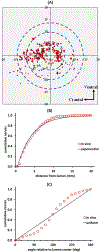Procedural and Anatomical Determinants of Multielectrode Renal Denervation Efficacy
- PMID: 31303108
- PMCID: PMC6738948
- DOI: 10.1161/HYPERTENSIONAHA.119.12918
Procedural and Anatomical Determinants of Multielectrode Renal Denervation Efficacy
Abstract
Radiofrequency renal denervation is under investigation for treatment of hypertension with variable success. We developed preclinical models to examine the dependence of ablation biomarkers on renal denervation treatment parameters and anatomic variables. One hundred twenty-nine porcine renal arteries were denervated with an irrigated radiofrequency catheter with multiple helically arrayed electrodes. Nerve effects and ablation geometries at 7 days were characterized histomorphometrically and correlated with associated renal norepinephrine levels. Norepinephrine exhibited a threshold dependence on the percentage of affected nerves across the range of treatment durations (30-60 s) and power set points (6-20 W). For 15 W/30 s treatments, norepinephrine reduction and percentage of affected nerves tracked with number of electrode treatments, confirming additive effects of helically staggered ablations. Threshold effects were only attained when ≥4 electrodes were powered. Histomorphometry and computational modeling both illustrated that radiofrequency treatments directed at large neighboring veins resulted in subaverage ablation areas and, therefore, contributed suboptimally to efficacy. Account for measured nerve distribution patterns and the annular geometry of the artery revealed that, regardless of treatment variables, total ablation area and circumferential coverage were the prime determinants of renal denervation efficacy, with increased efficacy at smaller diameters.
Keywords: catheter ablation; hypertension; models, animal; norepinephrine; renal artery.
Figures






Similar articles
-
Procedural and anatomical predictors of renal denervation efficacy using two radiofrequency renal denervation catheters in a porcine model.J Hypertens. 2018 Dec;36(12):2453-2459. doi: 10.1097/HJH.0000000000001840. J Hypertens. 2018. PMID: 30005030 Free PMC article.
-
Evaluation of renal nerve morphological changes and norepinephrine levels following treatment with novel bipolar radiofrequency delivery systems in a porcine model.J Hypertens. 2014 Aug;32(8):1678-91; discussion 1691-2. doi: 10.1097/HJH.0000000000000236. J Hypertens. 2014. PMID: 24875181 Free PMC article.
-
Selective Renal Denervation Guided by Renal Nerve Stimulation in Canine.Hypertension. 2019 Sep;74(3):536-545. doi: 10.1161/HYPERTENSIONAHA.119.12680. Epub 2019 Jul 22. Hypertension. 2019. PMID: 31327262
-
Percutaneous renal denervation and the second generation EnligHTN System.Minerva Cardioangiol. 2014 Feb;62(1):99-104. Minerva Cardioangiol. 2014. PMID: 24500220 Review.
-
Renal denervation for hypertension.Curr Probl Cardiol. 2014 Feb;39(2):35-51. doi: 10.1016/j.cpcardiol.2013.11.002. Epub 2013 Nov 11. Curr Probl Cardiol. 2014. PMID: 24412003 Review.
Cited by
-
Recent advances in managing primary hypertension.Fac Rev. 2020 Nov 4;9:4. doi: 10.12703/b/9-4. eCollection 2020. Fac Rev. 2020. PMID: 33659936 Free PMC article. Review.
-
Present Evidence of Determinants to Predict the Efficacy of Renal Denervation.Int J Hypertens. 2022 Aug 12;2022:5694127. doi: 10.1155/2022/5694127. eCollection 2022. Int J Hypertens. 2022. PMID: 35992203 Free PMC article. Review.
-
Pulmonary and Systemic Hemodynamics following Multielectrode Radiofrequency Catheter Renal Denervation in Acutely Induced Pulmonary Arterial Hypertension in Swine.Biomed Res Int. 2021 Nov 2;2021:4248111. doi: 10.1155/2021/4248111. eCollection 2021. Biomed Res Int. 2021. PMID: 34765677 Free PMC article.
-
Combined renal and common hepatic artery denervation as a novel approach to reduce cardiometabolic risk: technical approach, feasibility and safety in a pre-clinical model.Clin Res Cardiol. 2021 May;110(5):740-753. doi: 10.1007/s00392-021-01814-1. Epub 2021 Feb 26. Clin Res Cardiol. 2021. PMID: 33635438 Free PMC article.
-
Renal Denervation by Noninvasive Stereotactic Radiotherapy Induces Persistent Reduction of Sympathetic Activity in a Hypertensive Swine Model.J Am Heart Assoc. 2021 Aug 17;10(16):e020068. doi: 10.1161/JAHA.120.020068. Epub 2021 Aug 7. J Am Heart Assoc. 2021. PMID: 34369204 Free PMC article.
References
-
- Esler MD, Krum H, Schlaich M, Schmieder RE, Bohm M, Sobotka PA. Renal sympathetic denervation for treatment of drug-resistant hypertension: One-year results from the symplicity htn-2 randomized, controlled trial. Circulation. 2010;126:2976–2982 - PubMed
-
- Krum H, Schlaich MP, Bohm M, Mahfoud F, Rocha-Singh K, Katholi R, Esler MD. Percutaneous renal denervation in patients with treatment-resistant hypertension: Final 3-year report of the symplicity htn-1 study. Lancet. 2013 - PubMed
-
- Tsioufis C, Mahfoud F, Mancia G, Redon J, Damascelli B, Zeller T, Schmieder RE. What the interventionalist should know about renal denervation in hypertensive patients: A position paper by the esh wg on the interventional treatment of hypertension. EuroIntervention. 2014;9:1027–1035 - PubMed
-
- Bhatt DL, Kandzari DE, O’Neill WW, D’Agostino R, Flack JM, Katzen BT, Leon MB, Liu M, Mauri L, Negoita M, Cohen SA, Oparil S, Rocha-Singh K, Townsend RR, Bakris GL. A controlled trial of renal denervation for resistant hypertension. N Engl J Med. 2014;370:1393–1401 - PubMed
-
- Kandzari DE, Bhatt DL, Brar S, Devireddy CM, Esler M, Fahy M, Flack JM, Katzen BT, Lea J, Lee DP, Leon MB, Ma A, Massaro J, Mauri L, Oparil S, O’Neill WW, Patel MR, Rocha-Singh K, Sobotka PA, Svetkey L, Townsend RR, Bakris GL. Predictors of blood pressure response in the symplicity htn-3 trial. Eur Heart J. 2015;36:219–227 - PMC - PubMed
Publication types
MeSH terms
Substances
Grants and funding
LinkOut - more resources
Full Text Sources
Other Literature Sources
Medical

